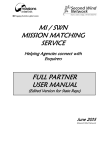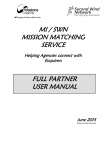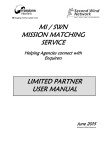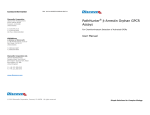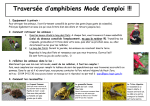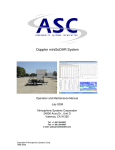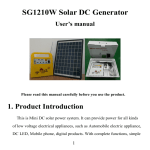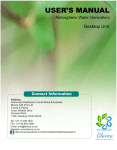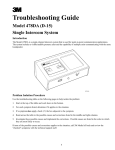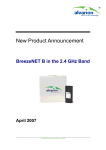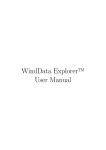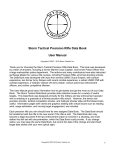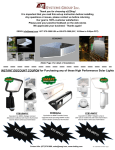Download Triton Siting Guidelines_9-2013.indd
Transcript
Siting Guidelines Version 2.2 PN 790-0006-004 TRITON® SONIC WIND PROFILER Siting Guidelines v. 2.2 PN 790-0006-004 Notices This manual and any examples contained are provided “as is” and are subject to change without notice. Second Wind Systems Inc. makes no warranty of any kind with regards to this manual, including, but not limited to, the implied warranties or merchantability and fitness for a particular application. Second Wind Systems Inc. shall not be liable for any errors or for incidental or consequential damages in connection with the furnishing, performance, or use of this manual or the examples contained in the manual. This document outlines guidelines that should be taken under consideration as a general approach to siting a Triton. As with any real-world application, environmental and site specific conditions can vary and cause unpredictable effects on the data. These guidelines cannot account for every possible scenario, but will provide a methodical strategy to reduce the probability of data degradation due to these phenomena. © Copyright 2013 by Second Wind Systems Inc. All rights reserved. Reproduction, adaptation, or translation of this manual is prohibited without prior written permission of Second Wind Systems Inc. Patents. Protected by US Patents: Patent 7,827,861 Patent 8,004,935 Patent 8,009,513 Other Patents Pending. About Second Wind Second Wind develops wind measurement systems that make wind power pay off for consumers, investors and the environment. The company’s technology provides wind farm developers with the wind data they need to plan, finance and operate highly efficient wind generation facilities. Second Wind’s systems are making wind farm development profitable in 50 countries on seven continents. Second Wind’s systems include Triton, the wind industry’s leading remote sensing system, Nomad® 2 wind data logger systems, the ProMastTM 60, a 60-meter meteorological mast and the SkyServe® web-based data service. For more information about Boston-based Second Wind, please visit www.secondwind.com. Second Wind 15 Riverdale Avenue Newton, MA 02458 Tel: +1 (617) 467-1500 Fax: +1 (617) 467-1567 E-Mail: [email protected] [email protected] Web: www.secondwind.com PN 790-0006-004 Triton Sonic Wind Profiler Siting Guidelines 3 Table of Contents 1.0 Introduction................................................................................................................................. 5 2.0 Triton Functional Overview........................................................................................................... 6 3.0 Scouting and Accurately Siting a Location ................................................................................... 7 3.1 Mapping Programs................................................................................................................. 7 3.2 Distance................................................................................................................................ 7 3.3 Height................................................................................................................................... 7 3.4 Bearing.................................................................................................................................. 7 4.0 General Guidelines for Siting Tritons............................................................................................ 8 4.1 Terrain Types.......................................................................................................................... 8 4.1.1 Flatland....................................................................................................................... 8 4.1.2 Coastal........................................................................................................................ 8 4.1.3 Complex Terrain........................................................................................................... 9 4.2 Ambient Noise....................................................................................................................... 10 4.2.1 Wildlife Noise............................................................................................................... 11 4.3 Trailer/Platforms/Anchoring..................................................................................................... 11 4.3.1 Additional Ambient Noise............................................................................................. 11 4.3.2 Resonance................................................................................................................... 11 4.4 Prevailing Wind Direction........................................................................................................ 12 4.5 Minimur Setback Distance...................................................................................................... 12 4.6 Fixed Echoes.......................................................................................................................... 13 4.6.1 Siting a Triton by Trees................................................................................................. 14 4.6.2 Siting a Triton Near Buildings....................................................................................... 15 4.6.3 Sample Triton Site........................................................................................................ 16 5.0 Siting Near Met Towers for Correlation Studies............................................................................ 17 6.0 Siting Considerations for Turbine Performance Evaluation............................................................ 18 Appendix 1........................................................................................................................................ 19 List of Figures Figure 1: The Triton Sonic Wind Profiler.......................................................................................... 5 Figure 2: Triton Beam Configuration............................................................................................... 6 Figure 3a-b: Triton in Beam Transmit (left) and Receive (right) Mode.................................................... 6 Figure 4: Triton Beam Orientation (Top View).................................................................................. 6 Figure 5: Installing a Triton Near the Coastline................................................................................ 8 Figure 6: Installing a Triton on a Plateau........................................................................................ 9 Figure 7: Installing a Triton in Complex Terrain............................................................................... 9 Table 1: Triton Setback Distance as a Ratio of Height.................................................................... 12 Figure 8: Yawing the Triton to Account for Southerly Wind............................................................... 12 Figure 9: Positioning Fixed Objects Between the Beams.................................................................. 13 Figure 10: Installing a Triton Where Clear-Cutting is Possible with 20m Trees..................................... 14 Figure 11: Installing a Triton Where Clear-Cutting is not Possible with 20m Trees............................... 14 Figure 12: Installing a Triton with Buildings Present........................................................................... 15 Figure 13: Proper Orientation in Relation to Buildings....................................................................... 15 Figure 14: Sample Triton Location.................................................................................................... 16 Table 2: Triton Setback Distance as a Ratio of Height for Correlation Studies.................................. 17 Figure 15: Installing a Triton for Correlation Studies.......................................................................... 17 Figure 16: Installing a Triton for Correlation Studies (Top View)......................................................... 17 Figure 17: Installing a Triton by Turbines........................................................................................... 18 Table 3: Setback Distance............................................................................................................ 19 PN 790-0006-004 Second Wind Systems Inc. 4 1.0 Introduction Second Wind’s Triton® Sonic Wind Profiler is a SODAR system designed for wind measurement campaigns in remote locations. The Triton’s ability to directly profile the wind resource throughout the rotor swept area of commercial utility-scale wind turbines makes it a useful stand-alone measurement device. These siting guidelines outline Second Wind’s recommended practices for siting a Triton for the following types of applications: • Wind resource assessment • Met tower correlation studies • Wind condition monitoring on operating wind farms The first step towards acquiring high-quality and valid Tritondata is to properly site the Triton. Second Wind defines “siting” as the process of investigating and identifying a suitable location for the Triton to provide every opportunity available for it to operate to Second Wind’s performance standards. Figure 1: The Triton Sonic Wind Profiler Whether the purpose of the installation is to correlate with a meteorological (met) tower or to gain knowledge of a site, certain considerations need to be taken into account during site selection. With this revision, Second Wind is incorporating the experience gained from hundreds of Triton deployments and nearly 2.5 million operating hours in a variety of terrains, climates, and applications. Careful attention to siting will help avoid the surprise of compromised data. More specific details about Triton installation and operation can be found in the Triton Sonic Wind Profiler User’s Manual. The Triton Data Processing Guidelines describe best practices for processing data from Tritons. Both documents are available from Second Wind support. Second Wind may update these guidelines based on additional field experience, or new capabilities of Triton and SkyServe. The most recent guidelines are always available from Second Wind support. For any siting questions or concerns, please contact Second Wind support at: [email protected] or +1 617-467-1500 ext. 3. PN 790-0006-004 Triton Sonic Wind Profiler Siting Guidelines 5 2.0 Triton Functional Overview Understanding how the Triton works is helpful in planning its installation. The Triton measures wind speed by detecting the Doppler shift of highfrequency acoustic pulses emitted into the atmosphere. The Triton chirps in three consecutive directions designated as: A-, B- and C-beams (Fig. 2). All three beam directions are tilted 11.4° from the vertical axis (Fig. 3a-b) and are spaced 120° from one another (Figure 4). As described in Section 8.3: Orienting the Triton of the Triton Sonic Wind Profiler User’s Manual, the A-beam roughly points to the northeast, the B-beam to the south and the C-beam roughly to the northwest in the northern hemisphere (In the southern hemisphere, the A-beam points approximately southwest, the B-beam faces the north, and the C-beam is approximately to the southeast). Orientation of the Triton is discussed in more detail in Section Figure 2: 4.0. After each chirp, some of the Triton Beam Configuration acoustic energy is reflected back (or backscattered) due to thermal gradients in the atmosphere. The sound that is reflected back is called the return signal. The Triton measures the return signal and analyzes the frequency content at specified heights, which we refer to as station heights. The Triton calculates the wind speed along the beam (the radial wind speed) from the difference in frequency between the transmitted signal and the return signal. For every ten-minute interval, the average radial wind speeds are combined to form the horizontal wind speed, vertical wind speed and wind direction. Figure 3a-b: Triton in Beam Transmit (left) and Receive (right) Mode Figure 4: Triton Beam Orientation (Top View) PN 790-0006-004 Second Wind Systems Inc. 6 3.0 Scouting and Accurately Siting a Location To properly site a Triton, distances, heights, and bearings must be accurately measured for best performance. The following tools and techniques should be used before the Triton arrives at the site to ensure that an appropriate resource assessment location is available. 3.1 Mapping Programs Online mapping programs that include satellite photography can be useful. Google EarthTM is a free program offered by Google to access aerial photography of nearly every location on the planet. It is not intended to be a high-grade surveying or cartographic program, but it is excellent for providing an initial assessment of a particular location. Various measuring tools incorporated in the program can help in finding a suitable position for the Triton. Aerial photos should always be accompanied by a site visit, as Google’s aerial photos can be outdated and site conditions can change. For more information please visit http://earth.google.com. 3.2 Distance On-site, horizontal distance to a fixed object should be measured with a quality infrared or laser rangefinder. The NikonTM Forestry Pro or an equivalent model is ideal (specifications are on-line at www.nikon.com). Standing from the potential position of the Triton, all fixed objects within a 200m radius should be noted and recorded on the Triton Site Information Form and Checklist (Refer to Section 8.1 of the Triton Sonic Wind Profiler User’s Manual). 3.3 Height An infrared or laser rangefinder is capable of measuring the height of objects. Any significantly tall object (>5m) can reflect stray signals from a Triton and reduce data quality. Please refer to Section 4.6 Fixed Echoes. 3.4 Bearing It is important to have accurate compass bearing readings when siting a location for several reasons: • Wind Direction The default Triton azimuth assumes that the array door is facing true north and the solar panels are facing true south and will report all wind direction measurements using this default configuration. On-site personnel should either orient the Triton according to this configuration OR should enter any azimuth offset in the Triton ProLinkTM to compensate for the discrepancy (Refer to Section 8.6.6.1 of the Triton Sonic Wind Profiler User’s Manual). NOTE: The azimuth offset must be manually set in the southern hemisphere, as the Triton’s orientation needs to be reversed. • Avoiding Echoes from Objects If the Triton must be sited close to fixed objects, the Triton should be rotated to point the beams away from the object. Refer to Section 4.6 Fixed Echoes for more information. • Solar Charging To maximize the charging ability of the solar panels, they must directly face the equator or as close to it as possible to allow for maximum exposure to sunlight. PN 790-0006-004 Triton Sonic Wind Profiler Siting Guidelines 7 4.0 General Guidelines for Siting Tritons Whatever application the Triton will be used for, there are several main siting issues that need to be considered: 1. 2. 3. 4. 5. 4.1 Terrain types Ambient noise Trailers/Platforms/Anchoring Prevailing Wind Direction Surrounding fixed obstacles Terrain Types The versatility of the Triton enables it to be deployed across a broad range of terrain types. Just as wind conditions can depend on the topography and climate of a location, so can the Triton’s performance. The following section details recommendations for siting a Triton in common types of terrain. 4.1.1 Flatland Flatland typically includes agricultural farmland, open prairie or desert. It has negligible fluctuation in elevation over a large area (>5 km2). • Tritons placed in open terrain can experience high wind speeds at ground level that can cause significant noise, reducing data availability at higher heights. Shielding at ground level can reduce noise and increase data recovery. 4.1.2 Coastal Tritons can be deployed in coastal or other marine environments. Any offshore applications, though, should be discussed with Second Wind support at: +1 617-467-1500 ext. 3 or [email protected]. Figure 5: Installing a Triton Near the Coastline • Any Triton placed near a marine environment should be placed on a stable platform that does not rock. • The Triton should be raised above, or placed away from, any possible waves. PN 790-0006-004 Second Wind Systems Inc. 8 4.1.3 Complex Terrain The features of complex terrain affect wind speeds, directions, and turbulence. Ridgelines, cliffs, plateaus and other extreme locations can cause a non-uniform wind flow curvature. The Triton’s wind speed computations assume that the wind flow angle through the measurement area is constant. In complex terrain, it is possible that this assumption no longer holds true. Second Wind has used computation fluid dynamics (CFD) flow modeling to calculate and apply adjustments to the Triton’s readings with good success. If you are interested in learning more, contact Second Wind support at [email protected] or +1 617-467-1500 ext. 3. 1. Near a cliff edge, the winds will have a strong vertical component. A Triton on the edge of a cliff (within 5m) will most likely record large amounts of vertical wind velocity depending on wind direction (Figure 6). To accurately measure the horizontal wind speeds on site, place the Triton more than 5m from the edge of the cliff. 2. For complex wind geometry, increasing the number of measurement sites will reduce uncertainty and provide a better understanding of the wind resource at a particular location. Figure 6: Installing a Triton on a Plateau 3. The ground level wind speeds on ridgelines can be extremely high, creating ambient noise which will lead to reduced data availability at higher heights. When possible, situate the Triton on the downwind (leeward) side of a ridgeline, where the hill will offer some shielding from the wind (see Figure 7). Figure 7: Installing a Triton in Complex Terrain PN 790-0006-004 Triton Sonic Wind Profiler Siting Guidelines 9 4.2 Ambient Noise Because the Triton relies on acoustic reflections from the atmosphere, too much noise at a site can affect the quality of data. Ambient noise will be a problem if it is: • Loud • Sustained • Similar in frequency to the Triton Every time a Triton chirps, the return signal is always its strongest immediately after it reflects off temperature fluctuations at the lower heights. As the signal climbs and travels through more of the atmosphere, it progressively weakens as more of the signal deflects away from the Triton. Therefore, at locations with more ambient noise, the Triton is less likely to recover data at the upper station heights since there will be more interference with the weaker return signal. The Triton computes a Quality Factor that rates the quality of the data for each 10-minute period. By comparing the strength of the return signal at each station height to the ambient noise levels at the site, the Triton calculates a Signal-to-Noise Ratio (SNR) and uses this in computing the Quality Factor. A significantly loud and constant ambient noise source within the Triton’s operating frequency can affect the return signal at the upper station heights, resulting in a significantly lower SNR and Quality Factor. Ambient noise sources commonly found at most wind measurement sites, such as roads, railroads, and generators, can cause issues with data recovery under certain circumstances. Any constant and loud noise source can reduce data returns at the upper station heights. If the noise is infrequent (such as a rarely used road) or if the Triton is located sufficiently far from the source, then the average recovery rates should not suffer. Ground-level wind speeds greater than 20 m/s can cause a significant amount of wind noise at an exposed location. Some degradation of quality at the higher station heights should be expected unless the Triton is sheltered from the wind. The Triton can be sheltered by topographic features, or by trees around the Triton. If the Triton is sited in a location where high external ambient noise is known to exist, consideration should be given to introducing a barrier to the noise source. The use of hay bales surrounding the Triton, or a container that encloses the Triton (opened at the top) have resulted in higher data quality, and higher data recovery in high ambient noise locations. Second Wind support can advise on specific sheltering concerns. On a site with more than one Triton, take care to plan the distance between the Tritons. If two Tritons are too close to each other, they will interfere with each other’s measurements. We recommend a minimum spacing between Tritons of 600 meters. This is true for the Triton and other SODAR systems as well. PN 790-0006-004 Second Wind Systems Inc. 10 4.2.1 Wildlife Noise Some insects and amphibians, such as crickets and frogs, emit a noise with similar frequency components to the Triton (~4500 Hz ±250 Hz, dependent on temperature) that can reduce data quality. However, Triton Sodar firmware versions 2.0 and higher have the ability to automatically filter out these noises and improve data quality. By default, a Triton with these firmware versions includes: • A background noise filter that mitigates the adverse effects of insect and wildlife noise. • An enhanced Quality Factor (Q Factor) algorithm that reduces erroneous scatter in the Triton data. The net effect is a more intelligent Sodar application that minimizes the need for additional “cleaning” of Triton data after it is exported from SkyServe. 4.3 Trailer/Platforms/Anchoring The Triton adapts well to alternative installation strategies such as trailers and snow platforms. Trailers facilitate quick and easy redeployment of Tritons. Where snow accumulation is significant, snow platforms have been built to keep the Triton above the snow. At locations with high ground-level wind speeds, such as ridgelines, outriggers and sandbags have been used in addition to earth anchors to secure the Triton. For any customized platform or anchoring scheme, the following two issues should be addressed: 4.3.1 Additional Ambient Noise Some additional sources of ambient noise can include: • Wind passing throughout the platform or anchoring system can introduce a high level of ambient noise, and data recovery rates at higher station heights may suffer. If earth anchors cannot be used at the site, we recommend mounting the Triton on a pair of outriggers to offer additional stability. • Do not use nylon webbing straps. These can vibrate in high winds, causing significant ambient noise that can degrade data quality. • • Another common mistake is to leave securing devices hanging loose (i.e. chains, ends of rope or straps, etc.) that can flap in the wind or hit the side of the Triton. It is essential to secure or tie down any loose ends so that additional ambient noise will be minimized. Please refer to the Triton Anchoring Guidelines in the Triton Sonic Wind Profiler User’s Manual (Sec. 8.7) for further information. 4.3.2 Resonance If there are metal components on the platform or trailer, the Triton’s chirp may cause the metal parts to ring (i.e. resonate). The resonance can pollute the return signal and introduce noise to the wind speed measurement. Do not place a Triton directly on a metal surface; instead, have some acoustic dampening material, such as plywood, between the metal and the Triton. Ideally, there should be no direct contact between the Triton and an un-dampened metal part. Be careful when bolting a Triton to the metal deck of a platform. The metal coupling between the bolts and the metal can resonate. If possible, use a rubber stopper or gasket on the bolting hardware to reduce vibration. All platform and trailer designs should be discussed with Second Wind prior to deployment. For anchoring methods and instructions, refer to the Triton Sonic Wind Profiler User’s Manual. PN 790-0006-004 Triton Sonic Wind Profiler Siting Guidelines 11 4.4 Prevailing Wind Direction The B-beam typically faces south in the northern hemisphere and north in the southern hemisphere to maximize solar charging effectively. Figure 16 shows the location of the three Triton beams. However, in a small number of cases, measurement bias has been observed in high winds when the wind is oriented in a narrow sector (+/-15˚), coincident with the B-beam orientation. In the northern hemisphere, this phenomenon could occur when the wind is from the south and in the southern hemisphere, when the winds are from the north. In these cases, to avoid the possibility of this high wind bias, Second Wind recommends yawing (rotating the Triton about its vertical axis) to a new position that locates the B-beam of the Triton at least 30˚ away from the prevailing wind direction (Figure 8). Figure 8: Yawing the Triton to Account for Southerly Wind 4.5 If the wind orientation merits yawing of the unit, the efficiency of the solar panels may be reduced, particularly when the Triton is located at higher, or lower, latitudes. Second Wind can estimate the impact of yawing on available energy. Minimum Setback Distance The Triton needs to be located in a position such that none of the three beams are blocked by any objects on the site. Therefore, the Triton must be setback a minimum distance from any of these objects such that all three beams have a clear path above. Table 1 shows the obstacles typically encountered when siting a Triton and the minimum setback distance the Triton must be placed from them. For instance, for every meter of height of a treeline, the Triton must be half a meter away from the longest branches of that treeline. Always measure from the Table 1: Triton Setback Distance as a Ratio of Height branches, as measuring from the trunk of the tree may result in the Triton being too close to the tree. For buildings, the Triton must be three times the height of the building away. For other considerations when siting near these objects, please refer to the appropriate sub-sections below in Section 4.6 Fixed Echoes. For minimum setback distances when performing a met tower correlation study, please refer to Section 5.0 Siting Near Met Towers for Correlation Studies. PN 790-0006-004 Second Wind Systems Inc. 12 4.6 Fixed Echoes Fixed objects are objects like trees, buildings, or met towers. If the Triton is placed too close to a fixed object, sound reflections from the object may interfere with one of the main beams and adversely impact data collection at all station heights. These sound reflections are called “fixed echoes.” The Triton’s three beams are each oriented 11.4° from vertical and 120° apart horizontally. The design of the Triton enclosure and speaker array ensures that the majority of the acoustic energy is transmitted along these main beam paths. Aside from the acoustic energy from the main beams, there is a small amount of “side lobe” energy that travels laterally from the unit. If stationary objects are in the path of the side lobes (or the main beams), echoes with a zero frequency shift may be returned to the Triton. In such circumstances, the Triton’s returned signal would be a blend of fixed echoes and reflections from the atmosphere exhibited at a station height roughly equal to the Triton’s distance from the fixed obstacle. The fixed echoes and the actual wind speeds will be averaged together to create a wind speed that is low. This is known as a low bias. For example, a fixed object that is 60m laterally from the Triton could cause a low bias in the Triton’s 60m wind measurement. Second Wind has developed a fixed echo rejection algorithm for the Triton that significantly reduces the effects of fixed echoes. However, in low wind situations it is difficult for the algorithm to differentiate between wind measurements and echo sources, so Second Wind recommends avoiding sources of echoes whenever possible while siting the Triton. In real-world situations it is not always possible to avoid all sources of echoes. Therefore, one should consider the beam orientation with respect to surrounding obstacles (see Figure 9). The Triton should be situated such that none of the acoustic beams are aimed directly at a fixed object. This will reduce the strength of the fixed echoes, which will maximize the effectiveness of the echo rejection algorithm and minimize any low wind bias in the measured wind data. If fixed echoes cannot be addressed via rotation or translation due to the geometry of the site, the Triton can be oriented to anticipate the low wind bias depending on the purpose of the study. For example, the Triton can be placed 30m-40m from a fixed obstacle causing the low bias to appear at a lower station height that is of less significance to the measurement campaign. The effects on solar energy capture should be taken into account when orienting the Triton away from the true North-South axis. Figure 9: Positioning Fixed Objects Between the Beams If an object causes a fixed echo that overwhelms the signal, a new location may be required. Second Wind support can run a Triton Performance Study to scrutinize the first 10 days after an installation or relocation. The study will determine if there are any significant sources of fixed echoes that may be affecting the data as well as other performance parameters. If you are interested in receiving a study, please contact Second Wind support at [email protected] or +1 467-1500 ext. 3. PN 790-0006-004 Triton Sonic Wind Profiler Siting Guidelines 13 4.6.1 Siting a Triton by Trees Trees can pose challenges for the Triton at a potential wind site, but can be beneficial as well. Siting the Triton the proper distance away and with proper orientation is critical to avoid fixed echoes. The type of trees, density, and foliage can all affect the relative strength of the echoes. However, terrain with taller and denser foliage will have higher surface roughness and can shield Tritons from high ground level wind speeds and their ambient noise. Due to the indistinct geometry of forests and treelines, resultant echoes may not affect the data at the exact distance of the first line of trees. The echo may be exhibited up to 15 m beyond the beginning of the treeline depending on the density of the forest behind it. For example, a treeline that is 30m from the Triton can affect the 40m or, possibly, 50m data. When tree clearing is possible, remove all trees within a radius of the Triton equal to half of the height of the trees (Table 1). This relatively short distance will cause fixed echoes from the trees to affect the lower station heights where little or no energy will be generated. The 40m data may exhibit a low bias, however measurements above that height will not be affected. Some considerations for clear-cutting should be made if the Triton relies on solar charging and if the on-site solar resource may be limited. Figure 10 depicts an example site with 20m trees surrounding a 40m diameter clear-cut opening in the forest. The Triton is 10m from the northern edge of the clearing to satisfy the setback outlined in Table 1 and 30m from the southern edge to allow sufficient sunlight for the solar panels. Please refer to Appendix 1 for more information on clear-cutting for solar charging. Figure 10: Installing a Triton Where Clear-Cutting is Possible with 20m Trees If clear-cutting is not possible, please use the following guidelines: 1. Orient the Triton so none of the beams are pointed perpendicularly to the treeline. Note and record the Triton’s azimuth. Be aware that solar charging can be less efficient if the solar panels are not at a true 180° (northern hemisphere) or 0° (southern hemisphere) azimuth. 2. The Triton should be a minimum distance away from any tree or treeline equal to half of the height of the trees to avoid anything from blocking the main path of any of the beams. PN 790-0006-004 Figure 11: Installing a Triton Where Clear-Cutting is not Possible with 20m Trees Second Wind Systems Inc. 14 3. If the Triton is solar-powered, and there is low solar insolation at the site, then it should be located with the minimum setback against the treeline with the most sun exposure to prevent shading of the solar panels. 4. If the predominant wind direction is known before siting, place the Triton with the minimum setback against the windward side of the clearing (Figure 11). 4.6.2 Siting a Triton Near Buildings Buildings, when present, can affect the Triton data if siting issues are not properly addressed. Buildings can provide very strong fixed echoes due to their broader dimensions and reflective geometry. Please adhere to the following guidelines when siting near buildings: Figure 12: Installing a Triton with Buildings Present 1. The minimum distance between the Triton and any building should be equal to 3 times the height of the building. 2. The Triton should be positioned so that the building is outside the path of any of the three beams. The red area in Figure 12 indicates the minimum 45m distance that the Triton should be located away from that particular building. The Triton, located 60m from the building, is well outside the exclusion zone. 3. The Triton should be located so that no side of the building is directly facing the Triton. In other words, no side of the building should be perpendicular to any line coming from the Triton. This way, sound waves will be reflected away from the Triton instead of directly back at it. Figure 13 shows four positioning scenarios: • Of the four, only position 1 is a suitable location for the Triton in relation to the building. The building is 15m tall; therefore the Triton should be at least 45m away. Additionally, the Triton is positioned so that the building lies between the A- and B-beams. • Position 2 is a poor location as the building is at a 180° azimuth and directly in the path of the B-beam. Also, the path of the beam is perpendicular to the face of the building. • Position 3 is within the 45m setback from the building and is subsequently a poor position. Figure 13: Proper Orientation in Relation to Buildings • Position 4 has the A-beam of the Triton projected directly at the building, thus making it a poor site. Additionally, concave corners of buildings are more prone to reflecting sounds waves and should be avoided. PN 790-0006-004 Triton Sonic Wind Profiler Siting Guidelines 15 4.6.3 Sample Triton Site This section illustrates how to incorporate the different guidelines in an applied setting. Figure 14 depicts a Triton being used in a project where a correlation study is not being performed. This site is a typical flatland agricultural site. The Triton is placed in an optimal position in relation to several immobile objects that could create fixed echoes. • The 60m met tower (1) is at least 60m from the Triton and is also due west so it is not in the path of any of the Triton’s beams. • The forest to the north of the Triton (2) is at least the minimum setback from the Triton and also lies between the Triton’s A- and C-beams. • The barn (3) at 140m from the Triton is positioned between the A- and B-beams, but more importantly, none of the faces of the barn are directly facing the Triton. • The cabin (4) is not of any importance to the Triton as it is outside its 200m-measurement radius. Figure 14: Sample Triton Location PN 790-0006-004 Second Wind Systems Inc. 16 5.0 Siting Near Met Towers for Correlation Studies Some customers may wish to correlate their Triton with an on-site met tower before it is relocated for independent measurement. However, it is important to note that the Triton does not require calibration for it to be able to undertake a measurement campaign. This section details additional siting considerations for met tower correlation studies that may not be required for standard resource assessment. Table 2 details the minimum setback distances that must be used when for Correlation Studies siting a Triton near a met tower for a correlation study. It is critical that the Triton is sufficiently far from the tower in order to allow for it to properly correlate with all anemometers at each station height. Table 2: Triton Setback Distance as a Ratio of Height To optimize the correlation, siting decisions will place a priority on high quality data at the correlation heights. These guidelines apply to both tubular and lattice towers. 1. The elevation of the Triton should be within 5m of the base elevation of the tower. 2. The Triton should be no farther than 150m from the base of the tower. 3. There should be no obstacles that could cause a fixed echo within a radius of the Triton equal to the height of the tower plus 10m. (For example, if using a 60m tower, there should be no fixed echoes within a 70m radius of the Triton such as Figures 15 and 16.) 4. The Triton should not be placed in a position where the tower is in the direct path of any of the Triton’s three beams. Figure 15: Installing a Triton for Correlation Studies PN 790-0006-004 Figure 16: Installing a Triton for Correlation Studies (Top View) Triton Sonic Wind Profiler Siting Guidelines 17 6.0 Siting Considerations for Turbine Performance Evaluation The Triton can be used on operating wind farms to measure wind conditions for many applications including performance testing and forecasting. The portability of the Triton allows for flexibility in strategically measuring shear, veer, turbulence and wake effects at multiple sites on a wind farm. To ensure high quality data when installing a Triton next to a turbine, the guidelines below should be followed. 1. If conducting a wake study, the minimum distance between the Triton and turbine should be approximately 2 times the hub height (Figure 17). 2. None of the Triton’s beams should be directly pointed at the turbine. 3. If conducting a correlation study with a met tower, ensure that there is at least a distance equal to the total height of the turbine (hub height plus blade length) between the Triton and the turbine. Figure 17: Installing a Triton by Turbines PN 790-0006-004 Second Wind Systems Inc. 18 Appendix 1 Clear-Cutting for Solar Charging As outlined in Section 4.6.1, some considerations may have to be made for clear-cutting a location to allow for solar charging. Several variables need to be taken under review as increasing the distance to the treeline on the sunward side of the Triton can also increase the likelihood of creating a fixed echo at an undesirable station height. Determining the distance from the sunward treeline is largely dependent on two things: the height of the trees and the elevation of the sun. To measure the height of the trees, please refer to Section 3.3. The elevation of the sun relies upon the date and the location of the Triton. The National Oceanic and Atmospheric Administration has an online solar calculator that can provide the solar elevation for any date and location. The calculator is located at: http://www.esrl.noaa.gov/gmd/grad/solcalc/ The solar elevation should be calculated over a series of dates at noon in the winter months since that is when the sun will follow its lowest path through the sky. Using the following formula, the setback distance can be graphed over this period to determine a suitable setback distance: d= h Ta n (θ ) Where d is the setback distance from the sunward treeline, h is the height of the treeline, and θ is the solar elevation. An example of such a graph is displayed in Table 3 with a Triton at a 40˚ latitude. At this point, the setback distance should be determined with precedence given to either solar charging or echo management if the distance cannot satisfy both priorities. Table 3: Setback Distance PN 790-0006-004 Triton Sonic Wind Profiler Siting Guidelines 19





















